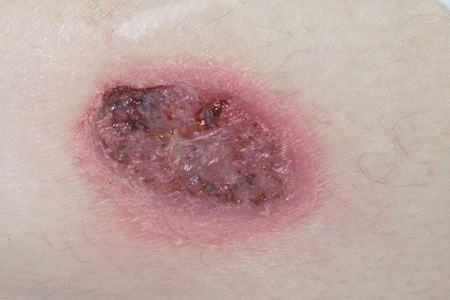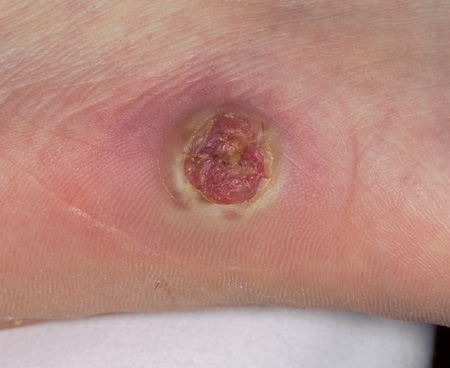History and exam
Key diagnostic factors
common
recreational or occupational exposures
primary residence in or travel to endemic areas
Other diagnostic factors
common
male sex
Males outnumber females from 4:1 to 15:1.[23]
constitutional symptoms
Fever, weight loss, or fatigue may occur.
cough
Cough with purulent sputum is a common complaint in pulmonary disease caused by Blastomycosis. However, asymptomatic pulmonary involvement is frequently diagnosed by chest radiograph, and disseminated disease spread hematogenously may be the first clinical clue to disease.
skin lesions
Skin lesions are usually chronic and can appear nodular, ulcerated, or verrucous. Typically have a raised irregular border. Skin lesions are the second most common manifestation of blastomycosis. [Figure caption and citation for the preceding image starts]: Cutaneous blastomycosis on the lower extremityLuAnn Ziemer, Office of Medical Photography, Mayo Clinic, Rochester, MN [Citation ends]. [Figure caption and citation for the preceding image starts]: Cutaneous blastomycosis on the lower extremityLuAnn Ziemer, Office of Medical Photography, Mayo Clinic, Rochester, MN [Citation ends].
[Figure caption and citation for the preceding image starts]: Cutaneous blastomycosis on the lower extremityLuAnn Ziemer, Office of Medical Photography, Mayo Clinic, Rochester, MN [Citation ends]. [Figure caption and citation for the preceding image starts]: Cutaneous blastomycosis on the forearmPersonal files of Larry Baddour, MD [Citation ends].
[Figure caption and citation for the preceding image starts]: Cutaneous blastomycosis on the forearmPersonal files of Larry Baddour, MD [Citation ends]. [Figure caption and citation for the preceding image starts]: Cutaneous manifestation of disseminated blastomycosisPersonal files of Larry Baddour, MD [Citation ends].
[Figure caption and citation for the preceding image starts]: Cutaneous manifestation of disseminated blastomycosisPersonal files of Larry Baddour, MD [Citation ends].
uncommon
animal exposure
A previous or coincident infection in a pet dog is a clue to environmental exposure of the fungus rather than a mode of transmission.
bone or joint pain
Bone or joint pain may be a clue to osteoarticular involvement with blastomycosis.
Presentation most frequently mimics a monoarticular, septic arthritis.
genitourinary symptoms
In men, blastomycosis can present with prostatitis, epididymo-orchitis, or infection of other genitourinary (GU) sites. Women can develop tubo-ovarian abscesses, endometritis and salpingitis.[5]
Always a manifestation of disseminated disease, but not all people with disseminated disease have GU involvement.
headache or focal neurologic complaints
Central nervous system involvement occurs in 5% to 10% of cases of blastomycosis and can manifest as meningitis or as a space-occupying lesion.[23]
Risk factors
strong
recreational or occupational exposures
Important exposures include to waterways with beaver dams or ponds, wooded areas, or river banks with rotting vegetation.[15][16]
One study using a lymphocyte stimulation assay found that 30% of forestry workers in Northern Minnesota and Wisconsin had been exposed to Blastomyces dermatitidis in the past.[25] Direct inoculation of the skin has occurred with various types of outdoor and occupational activities.[24]
travel to or residence in an area of endemicity
Although occasional sporadic cases have a worldwide distribution, areas of high endemic rates include the Midwestern, South Central and Southeastern US along the Mississippi river valley, Canada, and South Africa.[13][14][17][18][26][27][28] Data also suggest that blastomycosis may be endemic in the Northeastern region of the US.[11][12]
weak
male sex
Cases in men typically outnumber those in women, with a ratio between 4:1 and 15:1 depending on the series. However, this is generally thought to be secondary to increased environmental exposure in men as opposed to an actual sex predilection.[15]
immunocompromise
Blastomycosis does not appear to be more common in people who are immunocompromised. However, infection in a compromised host is more frequently complicated with adult respiratory distress syndrome or extrapulmonary dissemination.[29]
Very few patients with HIV/AIDS develop disseminated disease. This is because neutrophils are important for the host defense of blastomycosis, and patients with HIV/AIDS generally have T-cell defects but intact neutrophil function.
Use of this content is subject to our disclaimer